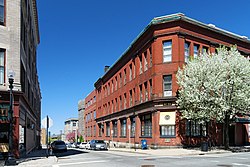Downtown Fall River Historic District | |
 Bank Street, Downtown Fall River | |
| Location | Fall River, Massachusetts |
|---|---|
| Coordinates | 41°42′11″N71°9′21″W / 41.70306°N 71.15583°W |
| Built | 1845 |
| Architectural style | Late 19th And 20th Century Revivals, Late Victorian |
| MPS | Fall River MRA |
| NRHP reference No. | 83000662 [1] |
| Added to NRHP | February 16, 1983 |



Downtown Fall River Historic District is a historic district on North and South Main, Bedford, Granite, Bank, Franklin, and Elm Streets in Fall River, Massachusetts.
Contents
The district was added to the National Register of Historic Places in 1983.



